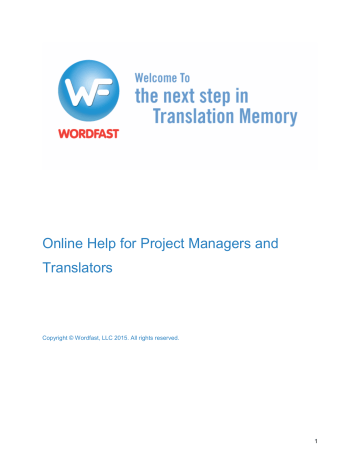

- #SOURCE AND TARGET TEXTS ALIGNMENTO FOR WORDFAST UPDATE#
- #SOURCE AND TARGET TEXTS ALIGNMENTO FOR WORDFAST SOFTWARE#
- #SOURCE AND TARGET TEXTS ALIGNMENTO FOR WORDFAST WINDOWS#
So when you are translating this phrase, you need to make sure to write your translation of “bold text” between the two sets of tags. What this means is that whenever there is some kind of formatting, Fluency will wrap the formatted text in tags that look like this. This also includes words that are underlined, in bold or in italics or that are written in a different font colour.
#SOURCE AND TARGET TEXTS ALIGNMENTO FOR WORDFAST UPDATE#
Since the newest update released just a few days ago, Fluency will replace all formatting elements with tags if you select this option during the process of project creation.

If there is a translation memory match, your screen reader or your computer’s SAPI voice will announce the percentage. There are also keyboard shortcuts for going to the next and previous segment, for marking a segment as complete and for copying the source sentence into the target pane. As I explained in a previous post about working with Fluency, there are keyboard shortcuts for navigating to each of these windows.
#SOURCE AND TARGET TEXTS ALIGNMENTO FOR WORDFAST WINDOWS#
In order to translate a text in Fluency, you have to navigate between different windows that contain the source text (CTRL+1), the translation you have written so far (CTRL+2) and the part where you type your translation of the current segment (CTRL+3). So even though there are some minor issues, it’s perfectly possible for a blind person to create a translation project. There are two checkboxes that are not labelled in a way that would let you know what they are for, but since there are only two of them, it’s easy to remember that the first one tells Fluency to pre-translate the text using TM matches, while the second one tells it to use machine translation on all segments. I will be focusing on the following key aspects of a CAT tool:Ĭreating a project in Fluency Now is quite simple, as I already explained in a previous post about Fluency. After all, CAT tools are designed to help the translator and to speed up his/her work, and not to slow them down and reduce their productivity.
#SOURCE AND TARGET TEXTS ALIGNMENTO FOR WORDFAST SOFTWARE#
So I can only evaluate the software from a user’s perspective and try to find out whether I am actually able to do a certain task and whether I am able to do it productively. I have to say, though, that I am not a programmer or anything along those lines. In my accessibility test, I’m going to use the latest version of Fluency called Fluency Now, and as a screen reader, I am using Jaws 17 together with a braille display.

To make it simple, I’m going to start with a CAT tool that I already know is accessible – Fluency – which I’m going to use as a benchmark to compare other tools with. By doing so, I want to find out which tools I can use productively, and to get a clearer understanding of which translation projects I can accept without having to worry about whether I’ll actually be able to use the required software. As many translation agencies require their translators to use a particular CAT tool, I’ve set out to test a number of them for their accessibility for blind users.


 0 kommentar(er)
0 kommentar(er)
